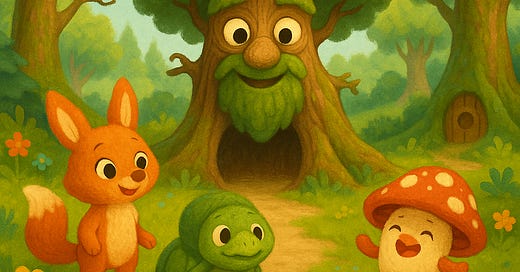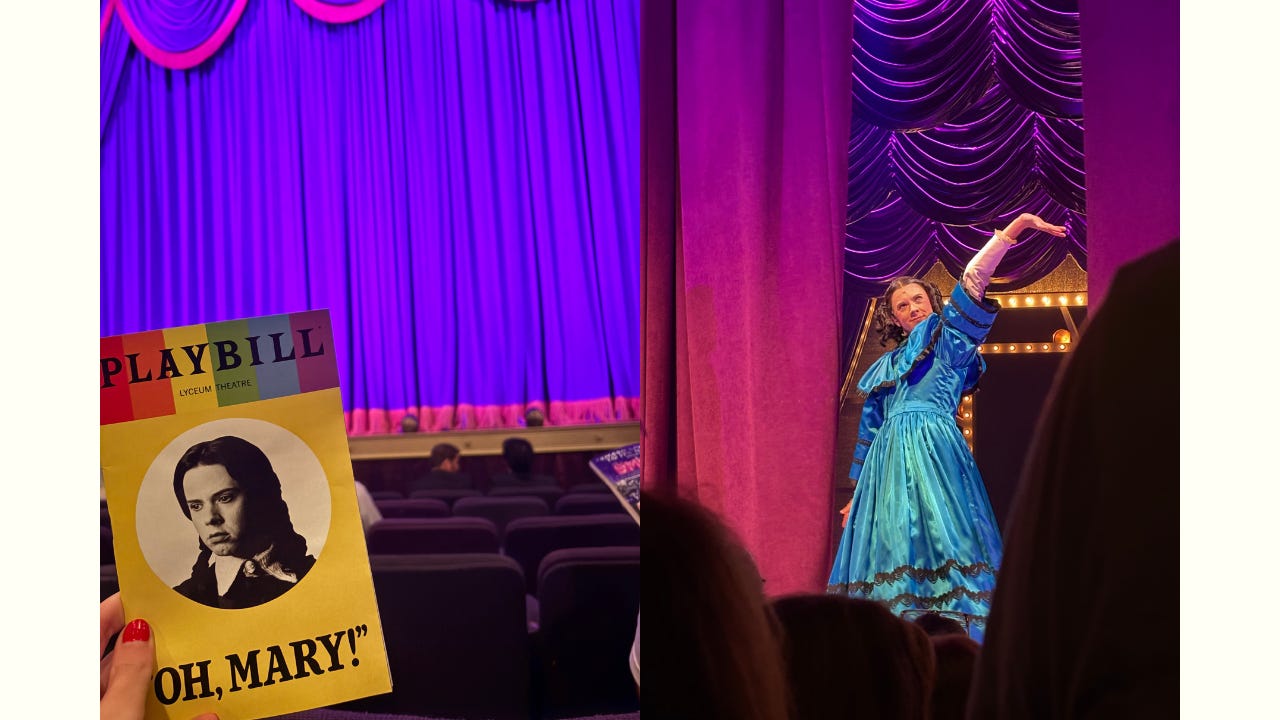I Asked ChatGPT to Create a Kids' TV Show — Here's What It Got Right (and What It Didn't)
Exploring AI’s creative potential—and its limits—through the lens of kids storytelling, pitch decks, and a frightening puppet tree.
This month, I’m diving headfirst into the controversial world of AI—not just as a headline, but with an open mind about its potential as a tool we can actually use. With that, I’ve challenged myself to explore how it might fit into my everyday life, and honestly, I’ve been surprised at what a helpful resource it has been.
One example: my job search. I’ve been using AI to help review my resume and highlight key accomplishments for specific roles. I’ve also had it come up with potential interview questions that I can prepare for and practice ahead of time. It’s like having a private career coach on demand.
I’ve also been deeeeeeep in Ancestry research with my Grandmother, and AI has been surprisingly helpful there too. I’ve used it to transcribe old handwriting from 18th century Croatian church books, translate documents, and help me piece together the story of my family’s past.
For Book Club this month, I’m reading Brave New Words by Salman Khan (If you want to read along with me, it’s not too late!) It’s already opening my eyes to the potential AI holds for students, especially in making complex topics more accessible and engaging. But it also surfaces important concerns around critical thinking, writing, and the need for human connection in learning.
But in this newsletter, I’m turning my focus toward creatives in the kids' media space, because a lot of us are wondering: what does AI mean for our work? For writers, artists, and producers, the fear is valid and even more concerning now in this state of the industry.
The instinct for many of us is to steer clear, but I worry if thoughtful creatives opt out completely, who’s left to shape how these tools get used? Instead of rejecting AI outright, what happens when we experiment, examine, and better understand what it can and can’t do.
So, I ran a little experiment. I asked ChatGPT to create a show for kids.
Spoiler alert: it’s… fine?
Prompt #1: “Give Me An Idea For A Kids Show”
I wanted to start from zero, so I created a new account on ChatGPT. I wanted to make sure there was no creative steering - no tone, no target demo, no educational goals. So, I kept it as simple and vague as possible: “Give me an idea for a kids’ show.”
I expected a sentence or two, but instead, it gave me a fully fleshed out pitch: title, age range, format, characters, themes, even interactive elements. It included all the elements you’d need to put together a pitch document.
✅ What Works?
The pitch includes everything you’d expect in a traditional concept doc: a clear title, age range, format, premise, characters, educational themes, and special segments. It understands the basic anatomy of a kids show and even sprinkles in familiar mechanics, like interactive questions and music breaks. The characters are purposeful (the question-asker, the thinker, the feeler), and the educational goals align with industry standards. If you were just trying to fill out a pitch template or needed a first-round concept to build from, this gets you there in under 10 seconds.
❌ What Doesn’t?
It’s missing a voice. The tone is generic, the character names are on the nose, and the premise, while functional, lacks the twist or specificity that makes something memorable and exciting. There’s no cultural point of view, no narrative surprise, no emotional hook. It’s technically correct, but it falls flat. There’s no personality and no real why.
Prompt #2: “Create an Image of Wigglewood”
It next asked ME if I wanted a theme song, a sample episode, or character designs. I went with character designs. Again, I gave it nothing to go on. I didn’t give any feedback on the initial pitch, nor specify animation style, character preferences, or even whether I liked the 2D/live-action mix it had pitched. I simply said, “Create an image of wigglewood.” And within seconds, it generated a visual interpretation of the characters, entirely based on its own pitch.
✅ What Works?
The style and texture of the image are genuinely impressive. The fox/rabbit hybrid and the turtle are cute and appealing, with a softness that’s in line with preschool aesthetics. The composition is clear, the colors are calm, and it captures the vibe of a whimsical, friendly forest setting.
For a zero-prompt image, it’s surprisingly cohesive. And frankly, it’s better than some placeholder art I’ve seen in pitch decks. For indie creators who can’t afford a visual development artist, this kind of tool could be a huge asset in moving beyond vague mood boards and into something that actually sells the vision.
❌ What Doesn’t?
While the image is polished, there’s elements that are a little… off. The mushroom character doesn’t really fit into the word and the tree with the face? Giving me the heebee-jeebies!
There’s something just off about some of the design choices. And that’s a key aspect to note: AI can mimic style, but it doesn’t yet have taste. It’s not iterating based on the narrative needs or emotional tone of the series, it’s just assembling patterns that look right. For visual development artists, that’s a good thing. AI might be able to generate a vibe, but it can’t yet bring in character or design choices that reflect personality: the finishing touches that really make a character pop.
Prompt #3: What Are 3 Sample Episodes?
Lastly, I asked for sample episodes. I wanted to see if it could generate storylines that matched the format it had suggested, something appropriate for an 11-minute bridge episode and if the characters would be used in ways that reflected their descriptions. Would the log lines feel age-appropriate and aligned with the educational goals it outlined. In other words: could it follow through on its own pitch the way a human writer would be expected to?
✅ What Works?
The episode ideas are solid. Each one follows a clear narrative arc, there’s a problem, a journey, and a lesson. The emotional beats are age-appropriate, the conflicts are relatable, and the educational takeaways align well with preschool curriculum goals. For someone staring at a blank page, this could be a helpful jumpstart.
❌ What Doesn’t?
The biggest issue? The stories don’t stay grounded in the world they’re supposed to be set in. Instead of deepening Wigglewood and making clever use of the characters or environment it already created, it tends to bolt on new magical items and locations. It’s like the world is just a backdrop, not a living, breathing ecosystem. In real development, that’s where the richness comes in: when your stories emerge from the characters, the rules of the world, and the dynamics you’ve already established. AI can write “a” story, but it’s not yet writing within a story world it’s created.
Final Thoughts
The pitch is… fine. Really. There are no glaring red flags, nothing laughably off-base, and nothing that screams “AI-generated.” (Ok MAYBE the tree, but I’ve seen way worse!) It’s age-appropriate and has the basic structure and legs a show needs to stand on. In fact, if this came across my desk as a first draft from a junior writer, I’d probably say, “This is a great start! Now let’s make it yours.” Because really, all that’s missing here? A voice and a point of view.
As I did the exercise, I was thinking a lot about Oh, Mary!, which I FINALLY saw this weekend. Cole Escola’s performance is wild, brilliant, and like nothing I’ve ever seen before. And it drives home the exact point I’m trying to make.
Oh, Mary! is a show that AI could never write. It’s built entirely around Cole’s humor, their instincts, and their weird and whacky mind. They wrote it for themselves, and you can tell from the moment it begins. Even Cole has said they weren’t sure if it would land with a broad audience. And in many ways, it hasn’t. Despite winning at the Tony Awards, plenty of people “don’t get it.” But for those who do? It’s unforgettable and inspiring.
And that’s what’s exciting for creatives. In this fragmented entertainment space, maybe we’re inching closer towards an unspoken permission to lean into your individual voice and not chase mass appeal. As content creation becomes easier and more accessible to anyone with an idea, the real mark of success won’t be how broadly something can reach, but how deeply it connects with the right audience. And I feel strongly that that’s something only a human will be able to do.
If we think of AI as a tool, rather than a replacement, it does open up interesting possibilities. After all, it only took ~ 5 minutes and a total of 17 words to get an idea that I could play around with and workshop.
At the end of the day, it’s still you, your voice, and your taste, that makes it matter. And it’s important to remember that’s the part AI can never replicate.
👋 Before You Go...
If you found this article interesting, please like, comment, share, or re-stack! It helps connect us to more creators, educators, and curious minds!
Want to read along with me? Grab your copy of this month’s book here.
Working on something for kids and families? Let’s connect! I’m looking for my next role and open for both full-time positions and/or freelance and consulting work. I help teams develop original kids’ series, build character-driven worlds, and bring stories to life across TV, digital, and emerging platforms. Learn more about my work and reach out to collaborate here 👉: www.julietmenz.com
If you have thoughts, ideas, or feedback on this newsletter, hit reply or DM me @kidsmediabookclub here or on IG. I’d love to hear from you!
Thanks for being part of Kids’ Media Book Club! ✨









Interesting post! I think this just goes to show that hitting all the points isn't enough to make a great show. You need something unique to your own voice if it's ever going to stand out.
It reminds me of a character design assignment I did in college. what I submitted was all "correct". Solid drawings, it rotated, I did the expressions that were asked of me. When I got a bad mark on it, I asked why and the instructor said that design was about more than being correct. He suggested if I took a look at those drawings in 6 months I would understand what he meant. I did, and he was right. It was missing the life.